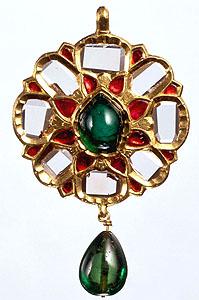
Jewelled Arts of India in the Age of the Mughals The Al-Sabah Collection 18 May - 2 September 2001 Fig.: Gold pendant set with rubies and chalcedony cameo portrait of Emperor Shah Jahan. Front, Mughal, 17th century, reverse, Deccan, 19th century. Height 4.22cm, diameter 3.34cm. © Bruce M. White Uses of jewels in the Mughal empire extended far beyond the simple adornment of women. In fact, most of the objects on view belonged to men; although elaborately jewelled the daggers and swords on display do not serve only as adornment but are entirely functional weapons. The extraordinary skill of the Indian stoneworkers is evident from the pieces on display and from larger undertakings such as the Taj Mahal, built by Shah Jahan as a tomb for his wife, meticulously inlaid with semi-precious stones. Shah Jahan was arguably the greatest of all the Mughal patrons and was clearly a man who appreciated stone carving in all of its manifestations. A member of the Kuwaiti ruling family, Sheikh Nasser has been collecting Islamic Art and jewelled objects in particular since the mid-1970s. Since 1983, the collection has been on loan to the Kuwait National Museum and during the occupation of Kuwait in 1990 the Iraqis took most of the contents of the museum to Iraq, where they remained until after the war ended. Although most of the collection was eventually repatriated, three of the most beautiful early Mughal carved emeralds have never resurfaced, including one the most important emeralds known to scholarship, another which features a religious inscription, and a gemstone with royal Mughal inscriptions To accompany the exhibition, Thames and Hudson is publishing ”Treasury of the World: Jewelled Arts of India in the Age of the Mughals¢ by Manuel Keene. This full colour presentation shows over 300 specially taken photographs, the great majority illustrating objects never previously published. ( £18.95 paperback original ).
|